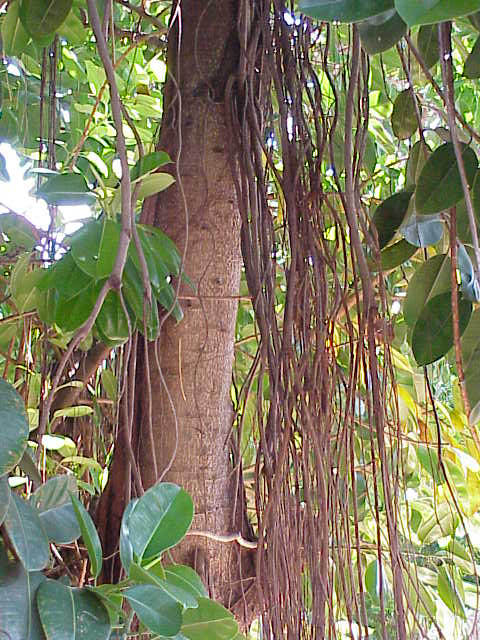- Ficus elastica
Taxobox
name = "Ficus elastica"

image_width = 240px
regnum =Plant ae
divisio = Magnoliophyta
classis =Magnoliopsida
ordo =Rosales
familia =Moraceae
genus =Ficus
subgenus = "Urostigma"
species = "F. elastica"
binomial = "Ficus elastica"
binomial_authority = Roxb."Ficus elastica", also called the rubber fig, rubber bush, rubber plant, or Indian rubber bush is a species of
plant in thefig genus, native to northeastIndia (Assam ), south toIndonesia (Sumatra and Java).It is a fat bush in the
banyan group of figs, growing to 30-40 m (rarely up to 60 m) tall, with a stout trunk up to 2 m diameter, with an irregular trunk which develops aerial and buttressing roots to anchor it in the soil and help support heavy branches. It has broad shiny oval leaves 10-35 cm long and 5-15 cm broad; leaf size is largest on young plants (occasionally to 45 cm long), much smaller on old trees (typically 10 cm long). The leaves develop inside a sheath at the apicalmeristem , which grows larger as the new leaf develops. When it is mature, it unfurls and the sheath drops off the plant. Inside the new leaf, another immature leaf is waiting to develop.As with other members of the genus "Ficus", the
flower s require a particular species offig wasp to pollinate it in a co-evolved relationship. Because of this relationship, the rubber plant does not produce highly colourful or fragrant flowers to attract other pollinators. Thefruit is a small yellow-green oval fig 1 cm long, barely edible; it will only contain viableseed where the relevant fig wasp species is present.Cultivation and uses
"Ficus elastica" is grown around the world as an
ornamental plant , outside in frost-free climates from the tropical to the Mediterranean and inside in colder climates as ahouseplant . Although it is grown inHawaii , the species of fig wasp required to allow it to spread naturally is not present there.In cultivation, it prefers bright sunlight but not hot temperatures. It has a high tolerance for drought, but prefers humidity and thrives in wet, tropical conditions. When grown as an ornamental plant hybrids derived from "Ficus elastica" Robusta with broader, stiffer and more upright leaves are commonly used instead of the wild form. Many such forms exist, often with variegated leaves.
Most cultivated plants are produced by
asexual propagation . This can be done by planting cuttings or airlayering . The latter method requires the propagator to cut a slit in the plant's stem. The wound, which oozes with the plant's latex sap, is packed with rooting hormone and wrapped tightly with moist sphagnum moss. The whole structure is wrapped in plastic and left for a few months. When it is unwrapped, new roots have developed from the plant's auxiliary buds. The stem is severed and the new plant is potted on its own.It can yield a milky white
latex also known as sap, which has been used in some cases to makerubber , but it should not be confused with thePara rubber tree , the main commercial source of latex for rubber making. This sap is also an irritant to the eyes and skin and can be fatal if taken internally.
Wikimedia Foundation. 2010.
